数据库相关
对于对数据库的操作,我们可以通过命令行终端(Dos)、可视化数据库软件进行操作,同时我们也可以通过Java进行对数据库的操作
通过Java操作Mysql
要求: 目的是为了体会通过Java发生SQL操作数据库、表
- 创建一个商品表(
goods),选用适当的数据类型 - 添加1条数据
- 删除
goods表
public class JavaMysql {
public static void main(String[] args) throws Exception {
// 加载类,得到mysql连接
Class.forName("com.mysql.jdbc.Driver");
Connection connection = DriverManager.getConnection("jdbc:mysql://localhost:3306/mysql_db01");
// 编写sql语句 执行一条注释一条
// String sql = "create table goods (id int, name varchar(32), price double)";
// String sql = "insert into goods values(1, "西瓜", 10)";
String sql = "drop table goods";
// 得到statement对象,把sql语句发送给mysql执行
Statement statement = connection.createStatement();
statement.executeUpdate(sql);
// 关闭连接
statement.close();
connection.close();
}
}JDBC
JDBC为访问不同的数据库提供了统一的接口,为使用者屏蔽了细节问题。Java程序员使用JDBC,可以连接任何提供了JDBC驱动程序的数据库系统,从而完成对数据库的各种操作
JDBC的基本原理图
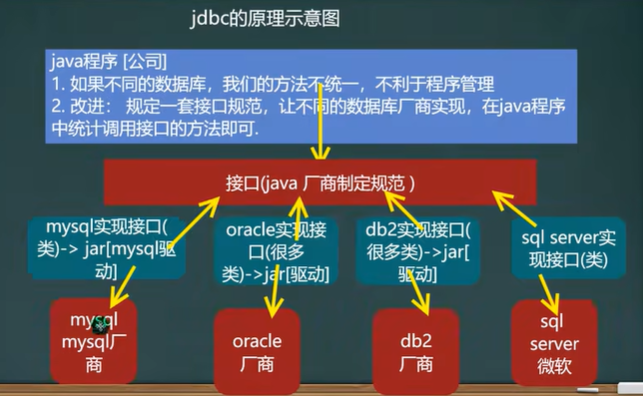
这里的接口就是
JDBC,是一组规范,用于数据库操作的接口API,JAVA程序员只需要面向这套接口编程即可,不同的数据库厂商,需要针对这套接口,提供不同的实现相关的类和接口在
java.sql和javax.sql包中
JDBC程序编写的步骤:
- 注册驱动--加载
Driver类 - 获取连接--得到
Connection(客户端(Java程序)到数据库的连接) - 执行增删改查--发送
SQL命令让mysql执行 - 释放资源--关闭相关的连接
// 一个简单的JDBC程序
public class Jdbc01 {
public static void main(String[] args) {
// 前置工作:在项目下创建一个文件夹,如libs,将mysql.jar拷贝到目录下,点击右键,选择add as library,加入到文件中
// 1. 注册驱动
Driver driver = new Driver(); // 创建driver对象
// 2. 得到连接
// jdbc:mysql:// 表示协议,是系统规定好的,通过jdbc的方式连接mysql
// localhost表示主机,也可以是IP地址 3306表示mysql监听的端口
// my_mysql表示连接到mysql的哪个数据库
String url = "jdbc:mysql://localhost:3306/my_mysql";
// 将用户名和密码放入到Properties对象中
Properties properties = new Properties();
// user和password是规定好的,后面的值根据实际的情况写入
properties.setProperty("user", "root"); // 指定用户名为root
properties.setProperty("password", "abc"); // 指定用户名为abc
// 得到连接
Connection connect = driver.connect(url, properties);
// 3. 执行sql语句
String sql = "insert into stu value(1, 'jlc', '男', '25')";
// statement用于执行静态的SQL语句并返回其生成的结果对象
Statement statement = connect.createStatement();
int rows = statement.executeUpdate(sql); // 如果是dml语句,返回的是受到影响的行数
System.out.println(rows > 0 ? "成功" : "失败");
// 4. 关闭连接资源
statement.close();
connect.close();
}
}连接数据库的方式
Java程序获取数据库连接的五种方式:
先
new一个Driver驱动对象,再通过driver.connect方法将url和用户信息传入,进行连接javaDriver driver = new com.mysql.jdbc.Driver(); // 创建driver对象 String url = "jdbc:mysql://localhost:3306/my_mysql"; Properties properties = new Properties(); properties.setProperty("user", "root"); properties.setProperty("password", "abc"); Connection connect = driver.connect(url, properties);该方式直接
new了一个driver对象,这里的Driver是第三方的,且是一个静态加载,灵活性不够强,依赖性比较高通过反射机制,进行动态的加载,可以将信息放入到配置文件中,更加灵活,减少依赖性,更利于项目的控制
javaClass<?> aClass = Class.forName("com.mysql.jdbc.Driver"); Driver driver = (Driver)aClass.newInstance(); String url = "jdbc:mysql://localhost:3306/my_mysql"; Properties properties = new Properties(); properties.setProperty("user", "root"); properties.setProperty("password", "abc"); Connection connect = driver.connect(url, properties);使用
DriverManager(用于管理一组JDBC驱动程序的基本服务)来替换Driver进行统一管理javaClass<?> aClass = Class.forName("com.mysql.jdbc.Driver"); Driver driver = (Driver)aClass.newInstance(); String url = "jdbc:mysql://localhost:3306/my_mysql"; String user = "root"; String password = "abc"; // 注册Driver驱动 DriverManager.registerDriver(driver); Connection connection = DriverManager.getConnection(url, user, password);使用
Class.forName自动完成注册驱动,简化代码javaClass.forName("com.mysql.jdbc.Driver"); // 在加载Driver类时,底层的静态代码块自动完成注册 String url = "jdbc:mysql://localhost:3306/my_mysql"; String user = "root"; String password = "abc"; Connection connection = DriverManager.getConnection(url, user, password);mysql驱动在5.1.6以后就无需使用Class.forName("com.mysql.jdbc.Driver");,也可以完成连接从
jdk1.5以后使用了jdbc4,不再需要显示调用Class.forName()注册驱动而是自动调用驱动jar包下META-INF\services\java.sql.Driver文本中的类名称去注册但是还是建议写上
Class.forName("com.mysql.jdbc.Driver");,因为更加明确在方式4的基础上,使用配置文件,连接数据库更加灵活(在开发的时候使用的最多)
java// 通过Properties对象获取配置文件的信息 Properties properties = new Properties(); properties.load(new FileInputStream("src\\jdbc.properties")); String user = properties.getProperty("user"); String password = properties.getProperty("password"); String url = properties.getProperty("url"); String driver = properties.getProperty("driver"); Class.forName(driver); Connection connection = DriverManager.getConnection(url, user, password);properties# jdbc.properties 配置文件 user=root password=abc url=jdbc:mysql://localhost:3306/my_mysql driver=com.mysql.jdbc.Driver
ResultSet
ResultSet表示数据库结果集的数据表,通常通过执行查询数据库的语句生成
ResultSet对象保持一个光标指向其当前的数据行。最初,光标位于第一行之前,next方法将光标移动到下一行,并且由于在ResultSet对象中没有更多行时返回false,因此可以在while循环中使用循环来遍历结果集
使用演示:
public class ResultSet01 {
public static void main(String[] args) throws Exception {
Properties properties = new Properties();
properties.load(new FileInputStream("src\\jdbc.properties"));
String user = properties.getProperty("user");
String password = properties.getProperty("password");
String url = properties.getProperty("url");
String driver = properties.getProperty("driver");
// 注册驱动
Class.forName(driver);
// 得到连接
Connection connection = DriverManager.getConnection(url, user, password);
// 得到Statement
Statement statement = connection.createStatement();
// 组织SQL语句
String sql = "select id, name, sex, age from stu";
// 执行给定的SQL语句,该语句返回单个的ResultSet对象
ResultSet resultSet = statement.executeQuery(sql);
// 使用while循环取出数据
while(resultSet.next()) { // 让光标向后移动,如果没有更多行,则返回false
int id = resultSet.getInt(1); // 获取该行的第一列
// 也可以通过对应的列名获取 int id = resultSet.getInt("id");
String name = resultSet.getString(2); // 获取该行的第二列
String sex = resultSet.getString(3);
int age = resultSet.getInt(4);
System.out.println(id + "\t" + name + "\t" + sex + "\t" + age);
}
// 关闭连接
resultSet.close();
statement.close();
connection.close();
}
}底层数据存储位置示意图:
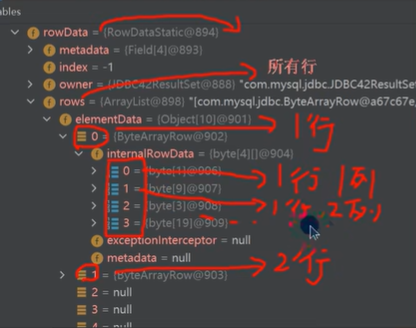
执行SQL语句
在连接建立后,需要对数据库进行访问,执行SQL语句,可以通过以下的方式:
Statement:Statement是一个接口,其对象用于执行静态的SQL语句,并返回其生成的结果的对象存在
SQL注入的问题,在实际的开发中使用的很少Statement对象执行SQL语句,存在SQL注入的风险(SQL注入是利用某些系统没有对用户输入的数据进行充分的检查,而在用户输入数据中注入非法的SQL语句段或命令,恶意攻击数据库)sql# 非法的SQL语句 SELECT * FROM admin WHERE NAME = '1' OR' AND pwd = 'OR '1'='1' # 这时就会将用户信息查询出来,但是显然是非法的,通过OR,只要一个条件成立,就将用户信息数据返回要防范
SQL注入的问题,只需要使用PreparedStatement(从Statement拓展而来)取代Statement即可PreparedStatement:是Statement接口的子接口,可以使用Statement的方法,同时特有的预处理方式,可以有效的解决SQL注入风险的问题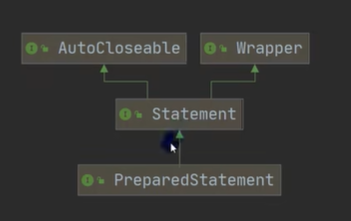
预处理方式,
PreparedStatement执行的SQL语句中的参数用(?)来表示javaString sql = "SELECT COUNT(*) FROM admin WHERE username = ? AND PASSWORD = ?";调用
PreparedStatement对象的setXxx()方法来设置这些参数。setXxx()方法有两个参数,第一个参数是要设置SQL语句中的参数索引(从1开始),第二个参数是设置的SQL语句中的参数值预处理的好处:
- 不再使用+来拼接
sql语句,减少语法错误 - 有效的解决了
sql注入问题 - 大大减少了编译次数,效率提高
调用
executeQuery(),返回ResultSet对象:java// 组织sql语句 语句中的?就相当于占位符 String sql = "SELECT name, pwd FROM admin WHERE name = ? AND pwd = ?"; PreparedStatement preparedStatement = connection.preparedStatement(sql); // 给sql语句中的?赋值 preparedStatement.setString(1, "root"); preparedStatement.setString(2, "abc"); // 执行select语句使用executeQuery方法 // 这里执行的时候,不能在写sql了,因为原先的sql已经被重置过了 ResultSet resultSet = preparedStatement.executeQuery();调用
executeUpdate(),执行更新,包括增、删、修改:java// 添加记录 String sql = "insert into admin values(?, ?)"; PreparedStatement preparedStatement = connection.preparedStatement(sql); preparedStatement.setString(1, "jlc"); preparedStatement.setString(2, "123"); int rows = preparedStatement.executeUpdate(); // 如果是dml语句,返回的是受到影响的行数 System.out.println(rows > 0 ? "成功" : "失败"); // 修改记录 String sql = "update admin set pwd = ? where name = ?"; PreparedStatement preparedStatement = connection.preparedStatement(sql); preparedStatement.setString(1, "789"); preparedStatement.setString(2, "jlc"); int rows = preparedStatement.executeUpdate(); // 如果是dml语句,返回的是受到影响的行数 System.out.println(rows > 0 ? "成功" : "失败"); // 删除记录 String sql = "delete from admin where name = ?"; PreparedStatement preparedStatement = connection.preparedStatement(sql); preparedStatement.setString(1, "jlc"); int rows = preparedStatement.executeUpdate(); // 如果是dml语句,返回的是受到影响的行数 System.out.println(rows > 0 ? "成功" : "失败");- 不再使用+来拼接
CallableStatement:主要用于存储过程
JDBC常用API小结
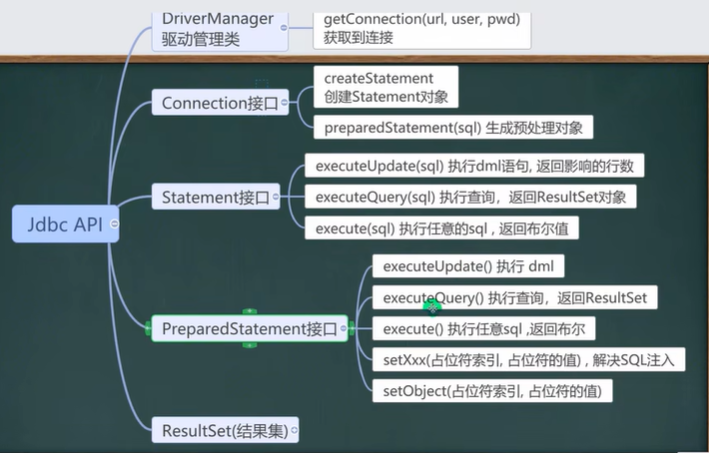
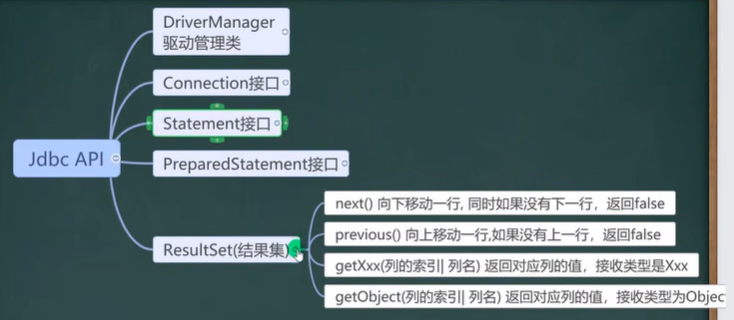
封装JDBCUtils类
在JDBC操作中,获取连接和释放资源是经常被使用到的,因此,我们可以将其封装成JDBC连接的工具类JDBCUtils
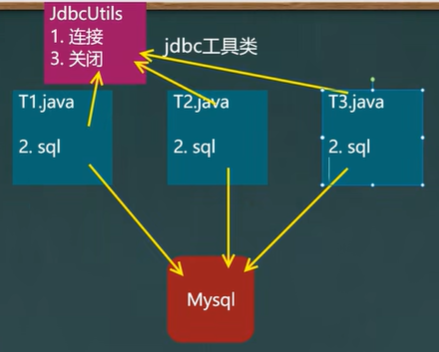
封装代码实现:
package com.test.jdbc.utils;
public class JDBCUtils {
// 定义相关的属性(4个),因为只需要一份,我们使用静态的即可
private static String user; // 用户名
private static String password; // 密码
private static String url; // url
private static String driver; // 驱动名
// 在static代码块中初始化
static {
try {
Properties properties = new Properties();
properties.load(new FileInputStream("src\\mysql.properties"));
// 获取相关的属性值
user = properties.getProperty("user");
password = properties.getProperty("password");
url = properties.getProperty("url");
driver = properties.getProperty("driver");
} catch (IOException e) {
// 在实际开发中,我们可以这样处理,将编译异常转换成运行异常进行抛出
// 调用者可以选择捕获该异常,或者选择默认处理该异常,比较方便
throw new RuntimeException(e);
}
}
// 连接数据库,返回Connection
public static Connection getConnection() {
try {
return DriverManager.getConnection(url, user, password);
} catch (SQLException e) {
throw new RuntimeException(e);
}
}
// 关闭相关资源
/*
1. ResultSet 结果集
2. Statement 或者 PreparedStatement
3. Connection
4. 如果需要关闭资源,就传入对象,否则传入null
*/
public static void close(ResultSet set, Statement statement, Connection connection){
try {
if(set != null) {
set.close();
}
if(statement != null) {
statement.close();
}
if(connection != null) {
connection.close();
}
} catch (SQLException e) {
throw new RuntimeException(e);
}
}
}封装代码的使用:
public class JDBCUtils_Use {
public void testDML { // insert, update, delete
// 得到连接
Connect connection = null;
// 组织sql语句
String sql = "insert into admin values(?, ?)";
PreparedStatement preparedStatement = null;
try {
connection = JDBCUtils.getConnection();
preparedStatement = connection.preparedStatement(sql);
preparedStatement.setString(1, "jlc");
preparedStatement.setString(2, "123");
int rows = preparedStatement.executeUpdate();
} catch (SQLException e) {
e.printStackTrace();
} finally {
// 关闭资源
JDBCUtils.close(null, preparedStatement, connection);
}
}
public void testSelect() {
// 得到连接
Connect connection = null;
// 组织sql语句
String sql = "select * from admin";
PreparedStatement preparedStatement = null;
ResultSet set = null;
try {
connection = JDBCUtils.getConnection();
preparedStatement = connection.preparedStatement(sql);
set = preparedStatement.executeQuery();
while(set.next()) {
String user = set.getString("user");
String pwd = set.getString("pwd");
System.out.println(user + "\t" + pwd);
}
} catch (SQLException e) {
e.printStackTrace();
} finally {
// 关闭资源
JDBCUtils.close(set, preparedStatement, connection);
}
}
}事务
基本介绍:
JDBC程序中当一个Connection对象创建时,默认情况下是自动提交事务的,即每次执行一个SQL语句时,如果执行成功,就会向数据库自动提交,而不能回滚JDBC程序中为了让多个SQL语句作为一个整体执行,需要使用事务- 调用
Connection的setAutoCommit(false)可以取消自动提交事务 - 在所有的
SQL语句都成功执行后,调用Connection的commit()方法进行提交 - 在其中某个操作失败或出现异常时,调用
Connection的rollback()方法回滚事务
使用事务来解决经典的转账问题:
public class Transaction_ {
public void Transaction() {
// 得到连接
Connect connection = null;
// 组织sql语句
String sql1 = "update account set balance = balance - 100 where id = 1";
String sql2 = "update account set balance = balance + 100 where id = 2";
PreparedStatement preparedStatement = null;
ResultSet set = null;
try {
connection = JDBCUtils.getConnection();
// 将connection设置为不自动提交
connection.setAutoCommit(false); // 开启事务
preparedStatement = connection.preparedStatement(sql1);
preparedStatement.executeUpdate(); // 执行第一条sql语句
preparedStatement = connection.preparedStatement(sql2);
preparedStatement.executeUpdate(); // 执行第二条sql语句
// 提交事务
connection.commit();
} catch (SQLException e) {
System.out.println("执行发生了异常,撤销执行的sql");
try {
// 出现异常,我们进行回滚,即撤销执行之前运行的sql语句
connection.rollback(); // 回滚到事务开启的时候
} catch (SQLException throwables) {
throwables.printStackTrace();
}
e.printStackTrace();
} finally {
// 关闭资源
JDBCUtils.close(null, preparedStatement, connection);
}
}
}批处理
基本介绍:
- 当需要成批插入或者更新记录时,可以采用
Java的批量更新机制,允许多条语句一次性提交给数据库批量处理,比单独提交处理更有效率 JDBC的批量处理语句包括:addBatch():添加需要批量处理的SQL语句或参数executeBatch():执行批量处理语句clearBatch():清空批处理包的语句(对于数据量特别大的情况,需要运送一批,清空后再运输)
JDBC连接mysql时,如果要使用批处理功能,请在url中加参数?rewritBatchedStatements=true- 批处理往往和
PreparedStatement一起搭配使用,既可以减少编译次数,又减少运行次数,效率大大提高
演示案例:向admin表中使用批处理的方式添加5000条数据
# jdbc.properties 配置文件 要使用批处理的方式,要加上?rewritBatchedStatements=true
user=root
password=abc
url=jdbc:mysql://localhost:3306/my_mysql?rewritBatchedStatements=true
driver=com.mysql.jdbc.Driverpublic class Batch_ {
public void Batch() throws Exception {
Connect connection = JDBCUtils.getConnection();
String sql = "insert into admin values(?, ?)";
PreparedStatement preparedStatement = connection.preparedStatement(sql);
for(int i = 0; i < 5000; i++) {
preparedStatement.setString(1, "jlc" + i);
preparedStatement.setString(2, "666");
// 将sql语句加入到批处理包中
preparedStatement.addBatch();
// 当有1000条记录时,批量执行
if((i + 1) % 1000 == 0) {
preparedStatement.executeBatch();
// 清空处理包语句
preparedStatement.clearBatch();
}
}
// 关闭连接
JDBCUtils.close(null, preparedStatement, connection);
}
}addBatch()的源码解析:
public void addBatch() throws SQLException {
synchronized(this,checkClosed().getConnectionMutex()) {\
// 第一次创建ArrayList了的对象数组elementData(Object[])来存放预处理的sql语句
// elementData数组的默认大小是10,当其满后,就按照1.5倍进行扩容
// 当添加到指定数量的值后,就executeBatch
// 批量处理会减小我们发送sql语句的网络开销,且减少编译次数,因此效率比较高
if (this.batchedArgs == null) {
this.batchedArgs = new ArrayList();
}
for (int i = 0; i < this.parameterValues.length; ++i) {
this.checkAllParametersSet(this.parameterValues[i], this.parameterStreams[i], i);
}
this.batchedArgs.add(new PrepardStatement.BatchParams(this.parameterValues, this.parameterStreams))
}
}数据库连接池
使用传统方式进行获取连接的问题分析:
- 对于传统的方式来获取连接,使用的是
JDBC中的DriverManager来获取,每次向数据库建立连接的时候都要将Connection加载到内存中,再验证IP地址、用户名和密码(耗时0.05s~1s时间)。需要数据库连接的时候,就向数据库要求一个,频繁的进行数据库连接操作将占用很多的系统资源,容易造成服务器奔溃 - 每一次数据量的连接,使用完后都得断开,如果程序出现异常而未能关闭,将导致数据库的内存泄漏,最终将导致重启数据库
- 传统获取连接的方式,不能控制创建的连接数量,如果连接过多,可能会导致内存泄漏,导致
mysql奔溃
解决传统开发中的数据库连接问题,可以采用数据库连接池技术
数据库连接池的基本介绍:
- 预先在缓冲池中放入一定数量的连接,当需要建立数据连接时,只需从“缓冲池”中取出一个,使用完毕之后再放回去
- 数据库连接池负责分配、管理和释放数据库连接,它允许应用程序重复使用一个现有的数据库连接,而不是重新建立一个
- 当应用程序向连接池请求的连接数量超过最大连接数量时,这些请求将被加入到等待队列中
数据库连接池示意图:
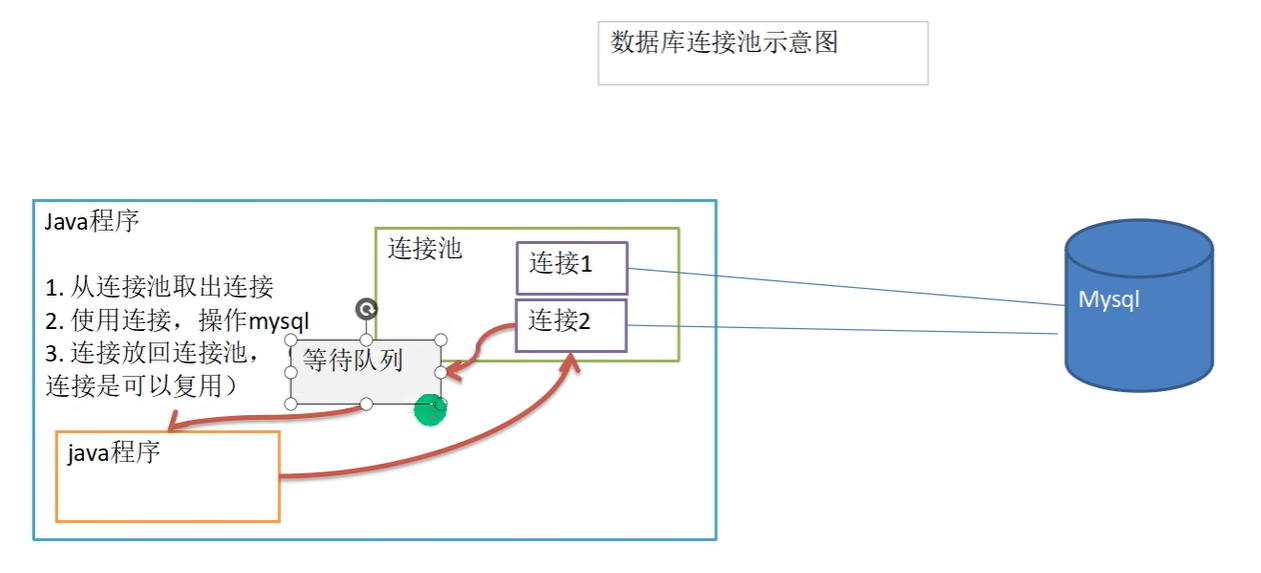
数据库连接池的种类:
JDBC的数据库连接池使用javax.sql.DataSource来表示,DataSource只是一个接口,该接口通常由第三方提供实现C3P0数据库连接池,速度相对较慢,稳定性不错(用的比较多)DBCP数据库连接池,速度相对C3P0较快,但不稳定Proxool数据库连接池,有监控连接池状态的功能,稳定性较C3P0差一点BoneCP数据库连接池,速度快Druid(德鲁伊)是阿里提供的数据库连接池,集DBCP、C3P0、Proxool优点于一身的数据库连接池(用的最多)
C3P0
使用C3P0时,我们先要加载C3P0对应的jar包,将包引入到我们的项目中
C3P0的使用演示:
方式一:相关参数user、url、password等,在程序中指定
public class C3P0_ {
public void testC3P0_01() {
// 1. 创建一个数据源对象
ComboPooledDataSource comboPooledDataSource = new ComboPooledDataSource();
// 2. 通过mysql.properties 获取相关的配置信息
// 通过Properties对象获取配置文件的信息
Properties properties = new Properties();
properties.load(new FileInputStream("src\\mysql.properties"));
String user = properties.getProperty("user");
String password = properties.getProperty("password");
String url = properties.getProperty("url");
String driver = properties.getProperty("driver");
// 给数据源设置相关的参数 连接的管理是由comboPooledDataSource来管理的
comboPooledDataSource.setDriverClass(driver);
comboPooledDataSource.setJdbcUrl(url);
comboPooledDataSource.setUser(user);
comboPooledDataSource.setPassword(password);
// 设置初始化的连接数,程序运行时,连接池中会存放设置数量的已经与数据库连接好的连接
comboPooledDataSource.setInitialPoolSize(10);
// 设置连接池的最大连接数,如果最大连接数的连接都被使用了,那么后续的连接请求会进入到等待队列中
comboPooledDataSource.setMaxPoolSize(50);
// 测试连接池的效率,对mysql连接500000次操作
long start = System.currentTimeMillis();
for(int i = 0; i < 500000; i++) {
// 获取连接 对应方法是从DataSource接口实现的
Connect connection = comboPooledDataSource.getConnection();
// 3. 关闭连接
connection.close();
}
long end = System.currentTimeMillis();
System.out.println("耗时" + (end - start));
}
}# mysql.properties 配置文件
user=root
password=abc
url=jdbc:mysql://localhost:3306/my_mysql
driver=com.mysql.jdbc.Driver方式二:使用配置文件模板来完成(推荐使用),将C3P0提供的c3p0.config.xml配置文件模板(该文件指定了连接数据库和连接池的相关参数)拷贝到src目录下,c3p0.config.xml配置文件模板的基本内容如下:
<c3p0-config>
<!--使用默认的配置读取数据库连接池对象 -->
<default-config name="hello">
<!-- 连接参数 -->
<property name="driverClass">com.mysql.jdbc.Driver</property>
<property name="jdbcUrl">jdbc:mysql://localhost:3306/my_mysql?useServerPrepStmts=true</property>
<property name="user">root</property>
<property name="password">abc</property>
<!-- 连接池参数 -->
<!--每次增长的连接数-->
<property name="acquireIncrement">5</property>
<!--初始化申请的连接数量-->
<property name="initialPoolSize">10</property>
<!--最小的连接数量 如果在一定时间内几乎没有程序进行连接,那么就会关闭连接数到最小的数量-->
<property name="minPoolSize">5</property>
<!--最大的连接数量-->
<property name="maxPoolSize">50</property>
<!--可连接的最多的命令对象数-->
<property name="maxStatements">5</property>
<!--每个连接对象可连接的最多的命令对象数-->
<property name="maxStatementsPerConnection">2</property>
</default-config>
</c3p0-config>public class C3P0_ {
public void testC3P0_02() {
// 1. 创建一个数据源对象,读取c3p0.config.xml配置文件,其name为hello的配置信息
ComboPooledDataSource comboPooledDataSource = new ComboPooledDataSource("hello");
// 测试连接池的效率,对mysql连接500000次操作
long start = System.currentTimeMillis();
for(int i = 0; i < 500000; i++) {
// 2. 获取连接 对应方法是从DataSource接口实现的
Connect connection = comboPooledDataSource.getConnection();
// 3. 关闭连接
connection.close();
}
long end = System.currentTimeMillis();
System.out.println("耗时" + (end - start));
}
}Druid
使用Druid数据库连接池,也是遵守连接池的基本原理的,该方式的连接池获取连接和关闭连接的效率是最高的
演示Druid连接池的使用:使用Druid时,我们先要加载Druid对应的jar包,将包引入到我们的项目中,同时加入Druid连接池的配置文件(拷贝到src目录即可,名称可以自定义,这里命名为druid.properties),该配置文件内容如下:
#key=value
driverClassName=com.mysql.jdbc.Driver
#URL连接数据库的URL
url=jdbc:mysql://localhost:3306/my_mysql?rewriteBatchedStatements=true
username=root
password=abc
#初始化物理连接的个数
initialSize=10
#最小连接池数量
minIdle=5
#最大连接池数量
maxActive=50
#获取连接时最大等待时间(在等待队列中最长等待的时间,如果超过这个时间,就放弃这次连接)
maxWait=5000public class Druid_ {
public void testDruid() throws Exception {
// 创建Properties对象,读取配置文件
Properties properties = new Properties();
properties.load(new FileInputStream("src\\druid.properties"));
// 创建一个指定参数的数据库连接池
DataSource dataSource = DruidDataSourceFactory.createDataSource(properties);
// 测试连接池的效率,对mysql连接500000次操作
long start = System.currentTimeMillis();
for(int i = 0; i < 500000; i++) {
// 获取连接
Connection connection = dataSource.getConnection();
// 关闭连接
connection.close();
}
long end = System.currentTimeMillis();
System.out.println("耗时" + (end - start));
}
}Druid工具类
我们一般也要将Druid进行封装(将获取连接和关闭连接作为方法封装起来),变成一个工具类
public class JDBCUtilsByDruid {
private static DataSource ds;
// 在静态代码块中完成初始化(只在加载类的时候,会初始化一次)
static {
Properties properties = new Properties();
try {
properties.load(new FileInputStream("src\\druid.properties"));
ds = DruidDataSourceFactory.createDataSource(properties);
} catch (Exception e) {
e.printStackTrace();
}
}
// 编写getConnection方法
public static Connection getConnection() throws SQLException {
return ds.getConnection();
}
// 关闭连接,在数据库连接池中,close不是断掉与数据库的连接,而是把使用的Connection对象放回连接池中
/*
1. ResultSet 结果集
2. Statement 或者 PreparedStatement
3. Connection
4. 如果需要关闭资源,就传入对象,否则传入null
*/
public static void close(ResultSet set, Statement statement, Connection connection){
try {
if(set != null) {
set.close();
}
if(statement != null) {
statement.close();
}
if(connection != null) {
connection.close();
}
} catch (SQLException e) {
throw new RuntimeException(e);
}
}
}封装工具类的测试:
public class Druid_ {
public void testDruid() throws Exception {
// 测试连接池的效率,对mysql连接500000次操作
long start = System.currentTimeMillis();
for(int i = 0; i < 500000; i++) {
// 获取连接
Connection connection = JDBCUtilsByDruid.getConnection();
// 关闭连接
JDBCUtilsByDruid.close();
}
long end = System.currentTimeMillis(null, null, connection);
System.out.println("耗时" + (end - start));
}
}ApDBUtils
ApDBUtils的基本引出和具体实现示意图:
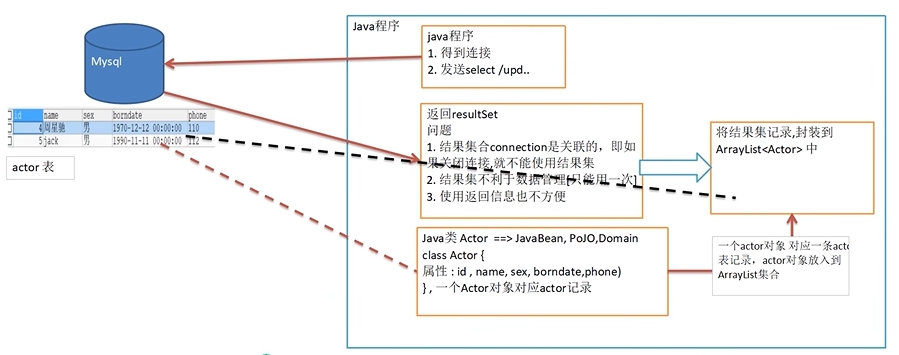
最后将数据保存到了
ArrayList<Actor>实例化出的集合中,后续断掉连接与数据库的连接,数据还是存在的(ArrayList和connection没有任何关联),还是可以进行复用
基本介绍:
commons-dbutils是Apache组织提供的一个开源JDBC工具类库,它是针对JDBC的封装,使用dbutils能极大的简化jdbc编码的工作量
DBUtils类:
QueryRunner类:封装了SQL的执行,是线程安全的,可以实现增删改查,批处理ResultSetHandler接口:用于处理java.sql.ResultSet,将数据按照要求转为另一种形式,常用的有:
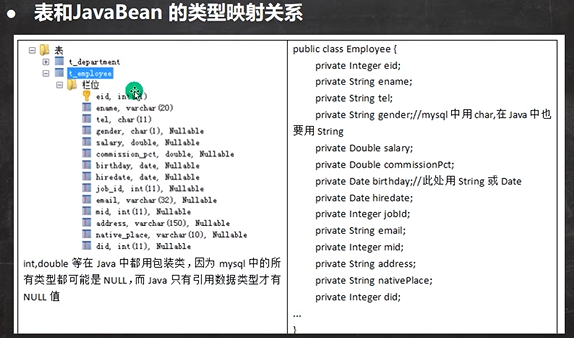
基本使用
案例演示:使用DBUtils+数据连接池(德鲁伊)方式,完成对表actor的增删改查:
使用DBUtils前需要引入相关的jar包,在加入到本项目中
多行查询
public class DBUtils_USE {
// 查询,返回的结果是多行的情况
public void testQueryMany() throws SQLException {
// 通过封装的德鲁伊方法,得到连接
Connection connection = JDBCUtilsByDruid.getConnection();
// 创建一个QueryRunner
QueryRunner queryRunner = new QueryRunner();
// 执行相关方法,返回ArrayList结果集
// query方法就是执行sql语句,得到resultset结果集,将其封装到ArrayList集合中,再返回
// connection:连接;sql:执行的sql语句;
// new BeanListHandler<>(Actor.class):将结果集取出Actor对象,封装到ArrayList中,底层使用了反射机制,去获取Actor类的属性,然后再进行封装
// 最后的1,是传递给sql语句中的?赋值,可以有多个值,因为是可变参数
String sql = "select * from actor where id >= ?";
List<Actor> list = queryRunner.query(connection, sql, new BeanListHandler<>(Actor.class), 1);
// 输出集合的信息
for(Actor actor: list) {
System.out.print(actor);
}
// 释放资源 底层得到的resultset和PreparedStatment,会在query中关闭
JDBCUtilsByDruid.close(null, null, connection);
}
}
sql语句也可以查询部分列
select id, name from actor where id >= ?那么,返回的结果对于没有指定查询的字段返回的内容是
null
单行查询
public class DBUtils_USE {
// 查询,返回的结果是单行的情况
public void testQuerySingle() throws SQLException {
// 通过封装的德鲁伊方法,得到连接
Connection connection = JDBCUtilsByDruid.getConnection();
// 创建一个QueryRunner
QueryRunner queryRunner = new QueryRunner();
// 执行相关方法,返回单个对象
// 因为返回的是单行记录,即单个对象,使用的Hander是BeanHandler
String sql = "select * from actor where id = ?";
Actor actor = queryRunner.query(connection, sql, new BeanHandler<>(Actor.class), 1);
// 输出信息
System.out.print(actor);
// 释放资源 底层得到的resultset和PreparedStatment,会在query中关闭
JDBCUtilsByDruid.close(null, null, connection);
}
}如果查询的结果不存在,返回的内容是
null
如果要查询的结果是单行单列的情况,返回的就是一个Object对象的形式
public class DBUtils_USE {
// 查询,返回的结果是单行的情况
public void testQueryScalar() throws SQLException {
// 通过封装的德鲁伊方法,得到连接
Connection connection = JDBCUtilsByDruid.getConnection();
// 创建一个QueryRunner
QueryRunner queryRunner = new QueryRunner();
// 执行相关方法,返回单个对象
// 因为返回的是单行记录,即单个对象,使用的Hander是BeanHandler
String sql = "select name from actor where id = ?";
Object obj = queryRunner.query(connection, sql, new ScalarHandler(), 1);
// 输出信息
System.out.print(obj);
// 释放资源 底层得到的resultset和PreparedStatment,会在query中关闭
JDBCUtilsByDruid.close(null, null, connection);
}
}如果查询的结果不存在,返回的内容是
null
增删改操作
public class DBUtils_USE {
// dml操作
public void testDML() throws SQLException {
// 通过封装的德鲁伊方法,得到连接
Connection connection = JDBCUtilsByDruid.getConnection();
// 创建一个QueryRunner
QueryRunner queryRunner = new QueryRunner();
// 组织sql语句,完成update、insert和delete
// 返回的affectedRow是受影响的行数,1表示sql语句执行成功,0表示执行失败
// 增
String sql = "insert into actor values(null, ?, ?)";
int affectedRow = queryRunner.update(connection, sql, "jlc", "男");
// 删
String sql = "delete from actor where id = ?";
int affectedRow = queryRunner.update(connection, sql, 1);
// 改
String sql = "update actor set name = ? where id = ?";
int affectedRow = queryRunner.update(connection, sql, "jlc", 1);
System.out.print(affectedRow > 0 ? "执行成功" : "执行失败");
// 释放资源 底层得到的resultset和PreparedStatment,会在query中关闭
JDBCUtilsByDruid.close(null, null, connection);
}
}BasicDao
apache-dbutils+Druid简化了JDBC的开发,但是还有不足:
SQL语句固定(如,所查的表固定),不能通过参数传入,通用性不好,需要进行改进,使执行更方便- 对于
select操作,如果有返回值,返回值类型不能固定,需要使用泛型 - 将来的表很多,业务需求复杂,不可能只靠一个
Java类完成
在实际的开发中,一般需要使用BasicDao进行优化,体现了各司其职的思想
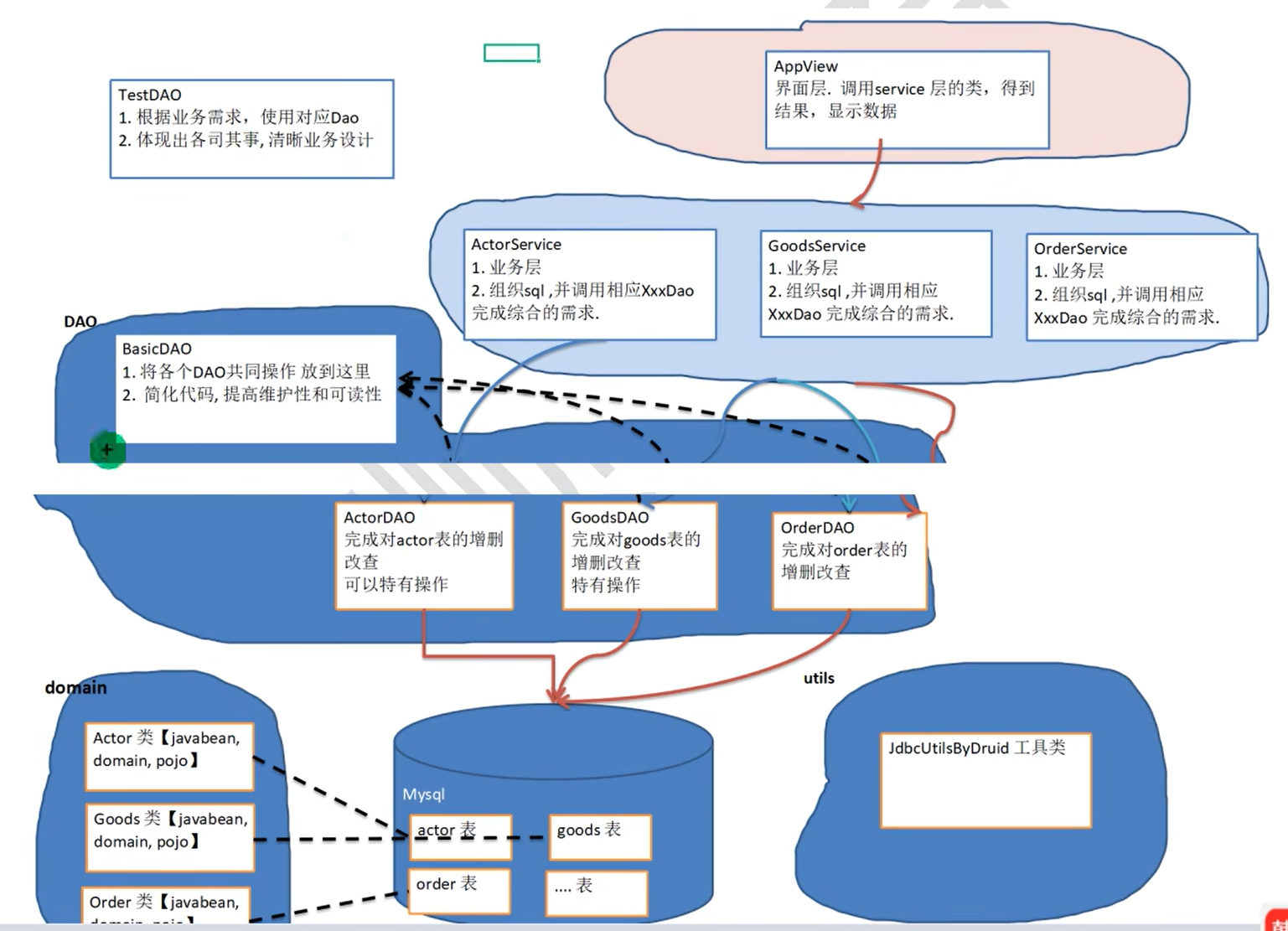
在实际开发中,一张数据表对应一个
DAO,该DAO完成对这张表的增删改查操作,对应共有的操作,我们将其放到BasicDao中,简化代码,提高了代码的维护性和可读性,同时每一张数据表与Java中的某一个类有映射关系
基本说明:
DAO:data access object数据访问对象- 这样的通用类,称为
BasicDao,是专门和数据库交互的,即完成对数据库(表)的crud操作 - 在
BasicDao基础上,实现一张表对应一个Dao,更好的完成功能,如Customer表--Customer.java类(javabean)--CustomerDao.java
设计实例:演示一套Actor的流程,其他数据表类似
com.test.dao_.utils:相关工具类javapackage com.test.dao_.utils; public class JDBCUtilsByDruid { private static DataSource ds; // 在静态代码块中完成初始化(只在加载类的时候,会初始化一次) static { Properties properties = new Properties(); try { properties.load(new FileInputStream("src\\druid.properties")); ds = DruidDataSourceFactory.createDataSource(properties); } catch (Exception e) { e.printStackTrace(); } } // 编写getConnection方法 public static Connection getConnection() throws SQLException { return ds.getConnection(); } // 关闭连接,在数据库连接池中,close不是断掉与数据库的连接,而是把使用的Connection对象放回连接池中 /* 1. ResultSet 结果集 2. Statement 或者 PreparedStatement 3. Connection 4. 如果需要关闭资源,就传入对象,否则传入null */ public static void close(ResultSet set, Statement statement, Connection connection){ try { if(set != null) { set.close(); } if(statement != null) { statement.close(); } if(connection != null) { connection.close(); } } catch (SQLException e) { throw new RuntimeException(e); } } }com.test.dao_.domain:Javabean具体对应数据表的Java类javapackage com.test.dao_.domain; import java.util.Date; public class Actor { private Integer id; private String name; private String sex; private Date borndate; private String phone; // 一定要给一个无参构造器,用于反射 public Actor() {} public Actor(Integer id, String name, String sex, Date borndate, String phone) { this.id = id; this.name = name; this.sex = sex; this.borndate = borndate; this.phone = phone; } fuction getName() { return name; } ... }com.test.dao_.dao:存放XxxDAO和BasicDAO先开发
BasicDAO(是其他DAO的一个父类)javapackage com.test.dao_.dao; import org.apache.commons.dbutils.QueryRunner; public class BasicDAO<T> { // 通过泛型指定类型 private QueryRunner qr = new QueryRunner(); // 开发通用的dml方法,针对任意的表 public int update(String sql, Object... parameters) { // parameters是可变参数 Connection connection = null; try { // 获取连接 connection = JDBCUtilsByDruid.getConnection(); // sql语句 int update = qr.update(connection, sql, parameters); } catch (SQLException e) { throw new RuntimeException(e); } finally { // 关闭连接 JDBCUtilsByDruid.close(null, null, connection); } } // 开发返回多行的查询结果,针对任意表 // sql是SQL语句,可以有? clazz传入一个Class对象,比如Actor.class // parameters传入?的具体的值,可以传入多个,是一个可变参数 // 最后返回根据Actor.class对应的ArrayList集合 public List<T> queryMulti(String sql, Class<T> clazz, Object... parameters) { Connection connection = null; try { // 获取连接 connection = JDBCUtilsByDruid.getConnection(); // sql语句 return qr.query(connection, sql, new BeanListHandler<T>(clazz), parameters); } catch (SQLException e) { throw new RuntimeException(e); } finally { // 关闭连接 JDBCUtilsByDruid.close(null, null, connection); } } // 开发查询单行的结果,针对任意表 public T querySingle(String sql, Class<T> clazz, Object... parameters) { Connection connection = null; try { // 获取连接 connection = JDBCUtilsByDruid.getConnection(); // sql语句 return qr.query(connection, sql, new BeanHandler<T>(clazz), parameters); } catch (SQLException e) { throw new RuntimeException(e); } finally { // 关闭连接 JDBCUtilsByDruid.close(null, null, connection); } } // 查询单行单列的方法,即返回单值的方法 public Object queryScalar(String sql, Object... parameters) { Connection connection = null; try { // 获取连接 connection = JDBCUtilsByDruid.getConnection(); // sql语句 return qr.query(connection, sql, new ScalarHandler(), parameters); } catch (SQLException e) { throw new RuntimeException(e); } finally { // 关闭连接 JDBCUtilsByDruid.close(null, null, connection); } } }开发
ActorDAO:继承BasicDAOjavapackage com.test.dao_.dao; import com.test.dao_.domain.Actor; public class ActorDAO extends BasicDAO<Actor> { // 有BasicDAO所有的方法 // 还可以根据需求,写特有的方法 }com.test.dao_.test:存放测试类javapackage com.test.dao_.test; public class TestDAO { // 测试ActorDAO 对 actor 表的crud操作 public void testActorDAO() { ActorDAO actorDAO = new ActorDAO(); // 查询多行 List<Actor> actors = actorDAO.queryMulti("select * from actor where id >= ?", Actor.class, 1); for (Actor actor: actors) { System.out.println(actor); } // 查询单行 Actor actor = actorDAO.querySingle("select * from actor where id = ?", Actor.class, 1); System.out.println(actor); // 查询单行单列 Object o actorDAO.querySingle("select name from actor where id = ?", 1); System.out.println(o); // dml操作 String sql = "update actor set name = ? where id = ?"; int update = actorDAO.update(connection, sql, "jlc", 1); System.out.print(affectedRow > 0 ? "执行成功" : "执行失败"); } }